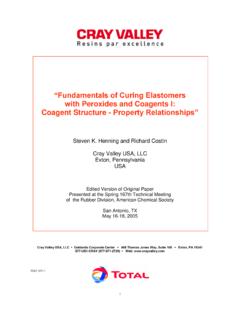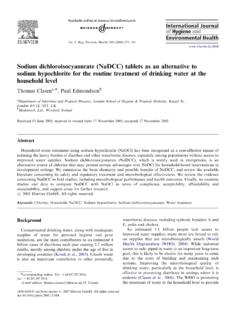Transcription of Sodium Dichloroisocyanurate in Drinking-water - WHO
1 WHO/HSE/ English only Sodium Dichloroisocyanurate in Drinking-water Background document for development of WHO Guidelines for Drinking-water Quality Sodium Dichloroisocyanurate in Drinking-water Background document for development of WHO Guidelines for Drinking-water Quality World Health Organization 2008 All rights reserved. Publications of the World Health Organization can be obtained from WHO Press, World Health Organization, 20 Avenue Appia, 1211 Geneva 27, Switzerland (tel.: +41 22 791 3264; fax: +41 22 791 4857; e-mail: Requests for permission to reproduce or translate WHO publications whether for sale or for non-commercial distribution should be addressed to WHO Press, at the above address (fax: +41 22 791 4806; e-mail: The designations employed and the presentation of the material in this publication do not imply the expression of any opinion whatsoever on the part of the World Health Organization concerning the legal status of any country, territory, city or area or of its authorities, or concerning the delimitation of its frontiers or boundaries.))
2 Dotted lines on maps represent approximate border lines for which there may not yet be full agreement. The mention of specific companies or of certain manufacturers products does not imply that they are endorsed or recommended by the World Health Organization in preference to others of a similar nature that are not mentioned. Errors and omissions excepted, the names of proprietary products are distinguished by initial capital letters. All reasonable precautions have been taken by the World Health Organization to verify the information contained in this publication. However, the published material is being distributed without warranty of any kind, either expressed or implied. The responsibility for the interpretation and use of the material lies with the reader. In no event shall the World Health Organization be liable for damages arising from its use. The named authors alone are responsible for the views expressed in this publication.
3 Printed by the WHO Document Production Services, Geneva, Switzerland Preface One of the primary goals of WHO and its member states is that all people, whatever their stage of development and their social and economic conditions, have the right to have access to an adequate supply of safe drinking water . A major WHO function to achieve such goals is the responsibility to propose .. regulations, and to make recommendations with respect to international health matters .. The first WHO document dealing specifically with public Drinking-water quality was published in 1958 as International Standards for Drinking-water . It was subsequently revised in 1963 and in 1971 under the same title. In 1984 1985, the first edition of the WHO Guidelines for Drinking-water Quality (GDWQ) was published in three volumes: Volume 1, Recommendations; Volume 2, Health criteria and other supporting information; and Volume 3, Surveillance and control of community supplies.
4 Second editions of these volumes were published in 1993, 1996 and 1997, respectively. Addenda to Volumes 1 and 2 of the second edition were published on selected chemicals in 1998 and on microbial aspects in 2002. The third edition of the GDWQ was published in 2004, the first addendum to the third edition was published in 2005, and the second addendum to the third edition was published in 2008. The GDWQ are subject to a rolling revision process. Through this process, microbial, chemical and radiological aspects of Drinking-water are subject to periodic review, and documentation related to aspects of protection and control of public Drinking-water quality is accordingly prepared and updated. Since the first edition of the GDWQ, WHO has published information on health criteria and other supporting information to the GDWQ, describing the approaches used in deriving guideline values and presenting critical reviews and evaluations of the effects on human health of the substances or contaminants of potential health concern in Drinking-water .
5 In the first and second editions, these constituted Volume 2 of the GDWQ. Since publication of the third edition, they comprise a series of free-standing monographs, including this one. For each chemical contaminant or substance considered, a lead institution prepared a background document evaluating the risks for human health from exposure to the particular chemical in Drinking-water . Institutions from Canada, Denmark, Finland, France, Germany, Italy, Japan, Netherlands, Norway, Poland, Sweden, United Kingdom and United States of America (USA) prepared the documents for the third edition and addenda. Under the oversight of a group of coordinators, each of whom was responsible for a group of chemicals considered in the GDWQ, the draft health criteria documents were submitted to a number of scientific institutions and selected experts for peer review. Comments were taken into consideration by the coordinators and authors.
6 The draft documents were also released to the public domain for comment and submitted for final evaluation by expert meetings. During the preparation of background documents and at expert meetings, careful consideration was given to information available in previous risk assessments carried out by the International Programme on Chemical Safety, in its Environmental Health Criteria monographs and Concise International Chemical Assessment Documents, the International Agency for Research on Cancer, the Joint FAO/WHO Meeting on Pesticide Residues and the Joint FAO/WHO Expert Committee on Food Additives (which evaluates contaminants such as lead, cadmium, nitrate and nitrite, in addition to food additives). Further up-to-date information on the GDWQ and the process of their development is available on the WHO Internet site and in the current edition of the GDWQ. Acknowledgements The first draft of Sodium Dichloroisocyanurate in Drinking-water , Background document for development of WHO Guidelines for Drinking-water Quality, was prepared by Mr Fawell, United Kingdom, to whom special thanks are due.
7 The work of the following working group coordinators was crucial in the development of this document and others contributing to the second addendum to the third edition: Dr J. Cotruvo, Joseph Cotruvo & Associates, USA (Materials and chemicals) Mr Fawell, United Kingdom (Naturally occurring and industrial contaminants) Ms M. Giddings, Health Canada (Disinfectants and disinfection by-products) Mr P. Jackson, WRc-NSF, United Kingdom (Chemicals practical aspects) Professor Y. Magara, Hokkaido University, Japan (Analytical achievability) Dr Festo Ngowi, Tropical Pesticides Research Institute, United Republic of Tanzania (Pesticides) Dr E. Ohanian, Environmental Protection Agency, USA (Disinfectants and disinfection by-products) The draft text was discussed at the Working Group Meeting for the second addendum to the third edition of the GDWQ, held on 15 19 May 2006. The final version of the document takes into consideration comments from both peer reviewers and the public.
8 The input of those who provided comments and of participants in the meeting is gratefully acknowledged. The WHO coordinators were Dr J. Bartram and Mr B. Gordon, WHO Headquarters. Ms C. Vickers provided a liaison with the Programme on Chemical Safety, WHO Headquarters. Mr R. Bos, Assessing and Managing Environmental Risks to Health, WHO Headquarters, provided input on pesticides added to Drinking-water for public health purposes. Ms Penny Ward provided invaluable administrative support at the Working Group Meeting and throughout the review and publication process. Ms Marla Sheffer of Ottawa, Canada, was responsible for the scientific editing of the document. Many individuals from various countries contributed to the development of the GDWQ. The efforts of all who contributed to the preparation of this document and in particular those who provided peer or public domain review comment are greatly appreciated.
9 Acronyms and abbreviations used in the text CAS Chemical Abstracts Service DCC Dichloroisocyanurate anion FAC free available chlorine FAO Food and Agriculture Organization of the United Nations GDWQ Guidelines for Drinking-water Quality HPLC high-performance liquid chromatography IUPAC International Union of Pure and Applied Chemistry JECFA Joint FAO/WHO Expert Committee on Food Additives NaDCC Sodium Dichloroisocyanurate NOEL no-observed-effect level TAC total available chlorine TDI tolerable daily intake UV ultraviolet WHO World Health Organization Table of contents 1. GENERAL DESCRIPTION .. 1 Identity .. 1 Physicochemical properties .. 1 Major uses and sources in Drinking-water .. 1 Environmental fate .. 1 2. EXPOSURE IN Drinking-water .. 2 3. TOXICOLOGICAL SUMMARY .. 2 Metabolism and toxicity .. 2 Evaluation .. 4 4. PRACTICAL ASPECTS .. 4 Analytical methods and analytical achievability .. 4 Treatment and control methods and technical achievability.
10 4 5. GUIDELINE VALUE .. 6 6. REFERENCES .. 6 1 This document is based on the JECFA review of Sodium Dichloroisocyanurate (WHO, 2004). 1. GENERAL DESCRIPTION Identity CAS No.: anhydrous 2893-78-9, dihydrate 51580-86-0 Molecular formula: anhydrous NaC3N3O3Cl2, dihydrate NaC3N3O3Cl2 2H2O The IUPAC name for Sodium Dichloroisocyanurate , or NaDCC, is 1,3-dichloro-1,3,5-triazinane-2,4,6-trio ne. It is also known as Sodium dichloro-s-triazine trione and Sodium troclosene. Physicochemical properties (IPCS, 2004) Property Value Relative molecular mass Melting point Decomposes below melting point at 230 C Relative density >1 water solubility (20 C) 25 g/100 ml (dihydrate 28 g/100 ml) Major uses and sources in Drinking-water NaDCC is the Sodium salt of a chlorinated hydroxytriazine and is used as a source of free available chlorine (FAC), in the form of hypochlorous acid (HOCl), for the disinfection of water . It is widely used as a stable source of chlorine for the disinfection of swimming pools and in the food industry, since it is more stable in sunlight than most other sources of chlorine.














